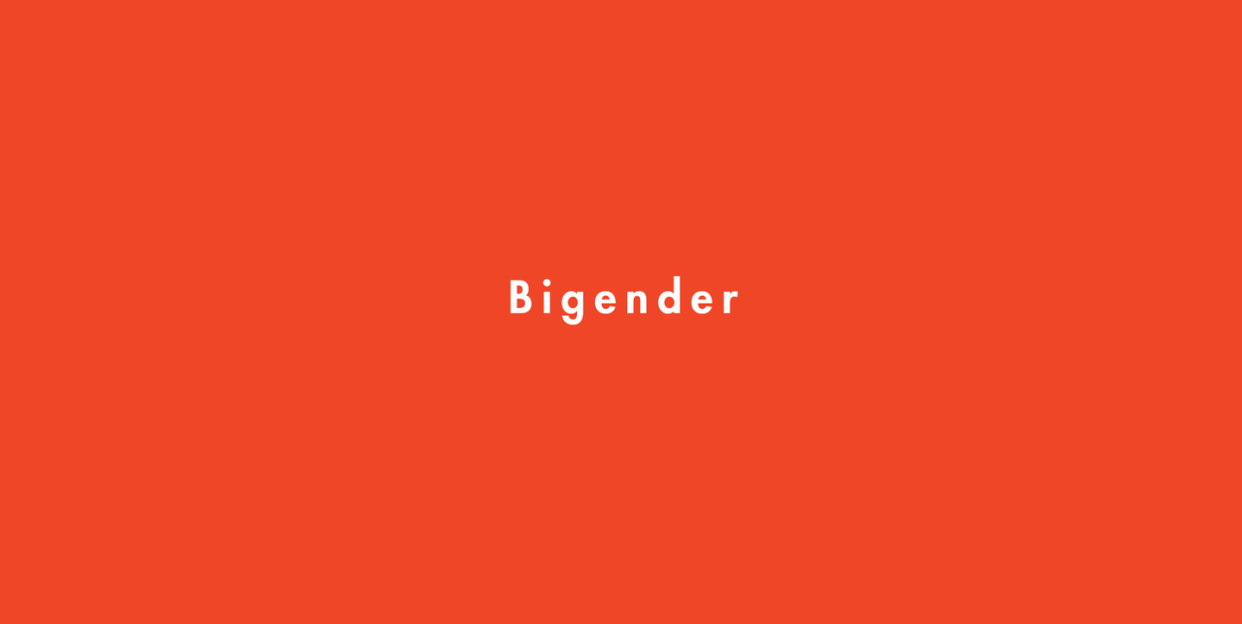Bigender

“Hearst Magazines and Verizon Media may earn commission or revenue on some items through the links below.”
While some people may think that you can only be one gender, that could not be further from the truth. There are plenty of gender identities for people who are more than one gender, including identities like genderfluid, pangender, and bigender.
Specifically, bigender “is a gender expansive term that describes a person who is two genders,” says sex educator Goody Howard. For example, people who are bigender can alternate between being masculine and feminine or they can be both at the same time. They can also be two gender identities, like female and male, or trans feminine and agender, or femme and genderqueer, etc.
It’s also important to note that there is no set pronoun for someone who is bigender, so it’s always important to ask for someone’s pronouns if you do not know. Additionally, being bigender is a gender identity. It has nothing to do with their sexual orientation or romantic attraction.
The difference between bigender, genderfluid, pangender, and bisexual
Like previously explained, a bigender person is two genders. But someone who is genderfluid, though, may experience themselves across multiple spectrums of gender, said Courtney D’Allaird, assistant director of the Gender and Sexuality Resource Center at the University of Albany, in a previous Cosmopolitan.com article. So someone who is genderfluid is not two genders like someone who is bigender.
Another term that you can hear in the same context as bigender is pangender. Unlike bigender, someone who is pangender “feels comfortable with different kinds of gender labels,” says Katie Lasson, a sexologist for Peaches and Scream, who previously explained in a Cosmopolitan.com article. This means a pangender person is a compilation of every gender known to them, like transgender, agender, non-binary, and more, all at once.
Then, when it comes to the differences between bigender and bisexuality, they operate on completely different spectrums. Bigender is a gender identity and bisexual is a sexual orientation. Bisexuality means being attracted to more than one gender, while bigender means you are two genders. You can be both bigender and bisexual at the same time.
What being bigender looks like
Because gender is a social construct, there’s really no right or wrong way to express your bigenderness. However, someone who is bigender might have no issue mixing feminine and masculine attitudes and clothing items—or they might stick with a strictly gender neutral fashion sense.
Because bigender expression is so unique, it’s important to honor a person by who they show you they are. Ask them their pronouns when you first meet them and respect them whenever they open up to you. And remember, no one has the obligation to either educate those around them or come out to them if they don’t want to.
Signs you might be bigender
Again, because there’s no right or wrong way to be bigender, there really is no set of rules that can determine, confirm, or deny your gender identity. However, Tatyana Dyachenko, a relationship expert psychologist and sex therapist at Peaches and Screams, revealed a few of the signs that you might be bigender:
You may not always relate to your assigned-at-birth sex. This could look like you feeling more male one day and then more female the next day. You might also just feel uncomfortable when someone uses your assigned-at-birth pronouns or assumes your gender.
You may dress both feminine and masculine at the same time. Again, expressing your bigender identity is totally unique and up to you.
You may have experienced gender dysphoria. Gender dysphoria is the sense of unease people might feel when there’s a mismatch between their gender identity and their biological sex. This could be because you either grew up in an environment where gender expression was assumed or because people around you do not respect your identity.
How to support friends or partners who are bigender
Someone who is bigender is no different than someone who is male or female, so there is absolutely no reason to treat them differently or discriminate against them. Goody says that “while the terms may be confusing to some, it’s important to remember that respect is free and affirming the gender identity of others doesn’t detract from your identity in any way.”
Additionally, she suggests supporting those who are bigender or any other identity by leveraging cisgender privilege to normalize pronoun usage—whether that’s by introducing yourself with your pronouns or adding them to email signatures and social media channels. You can also make sure to correct people when someone is misgendered and do your best to use the right pronouns yourself.
“If you misgender someone, apologize, repeat the phrase using the right pronouns, and move on,” adds Goody. “Don’t offer excuses or long apologies because it then calls for the person you misgendered to console you in the midst of harm you caused them.”
How to be a proud bigender person
Although there was a flag previously set for the bigender community, it was deemed as inappropriate and problematic due to its creator’s character. The creator, who had identified themselves as part of the LGBTQ+ community, was called out for allegedly being transphobic and abusive toward partners.
Since alleged proof of the creator’s character surfaced on Tumblr (TW: transphobia, rape, abuse, suicide, and manipulation), many people of the bigender community have rejected the use of the flag and are currently seeking a new one.
However, there are plenty of communities on social media, such as BiGender.net and the Bigender Reddit thread where people can get together and find support from fellow bigender people and allies. Bigender Pride Day is also celebrated on June 17.
You Might Also Like

